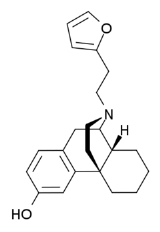
Ro4-1539
Encyclopedia
Ro4-1539 is an opioid
analgesic
drug from the morphinan
series, which was developed by the pharmaceutical company Hoffmann–La Roche in the 1950s. It acts as a potent μ-opioid
agonist, and was found to be around 30-60x more potent than the related drug levorphanol
in animal experiments. While it is notable for its high potency, being among the more potent μ-agonist found in the morphinan series of drugs (though not on the scale of acetorphine
and other morphinans in the extremity of their level of potency), Ro4-1539 had no particular clinical advantages over other available opioid drugs, and was never commercially marketed.
Ro4-1539 has never been formally trialled in humans, but based on its effects in animals it would be expected to produce effects similar to those of other potent opioid agonists, including strong analgesia, sedation
, euphoria
, constipation
, itching and also respiratory depression which could be harmful or fatal.
Opioid
An opioid is a psychoactive chemical that works by binding to opioid receptors, which are found principally in the central and peripheral nervous system and the gastrointestinal tract...
analgesic
Analgesic
An analgesic is any member of the group of drugs used to relieve pain . The word analgesic derives from Greek an- and algos ....
drug from the morphinan
Morphinan
Morphinan is the base chemical structure of a large chemical class of psychoactive drugs, consisting of opioid analgesics, cough suppressants, and dissociative hallucinogens, among others.- Chemical Derivatives :Immediate derivatives of morphinan include:...
series, which was developed by the pharmaceutical company Hoffmann–La Roche in the 1950s. It acts as a potent μ-opioid
Mu Opioid receptor
The μ-opioid receptors are a class of opioid receptors with high affinity for enkephalins and beta-endorphin but low affinity for dynorphins. They are also referred to as μ opioid peptide receptors. The prototypical μ receptor agonist is the opium alkaloid morphine; μ refers to morphine...
agonist, and was found to be around 30-60x more potent than the related drug levorphanol
Levorphanol
Levorphanol is an opioid medication used to treat severe pain. It is the levorotatory stereoisomer of the synthetic morphinan and a pure opioid agonist, first described in Germany in 1948 as an orally active morphine-like analgesic...
in animal experiments. While it is notable for its high potency, being among the more potent μ-agonist found in the morphinan series of drugs (though not on the scale of acetorphine
Acetorphine
Acetorphine is a potent analgesic drug, up to 8700 times stronger than morphine by weight. It is a derivative of the more well-known opioid etorphine, which is used as a very potent veterinary painkiller and anesthetic medication, primarily for the sedation of large animals such as elephants,...
and other morphinans in the extremity of their level of potency), Ro4-1539 had no particular clinical advantages over other available opioid drugs, and was never commercially marketed.
Ro4-1539 has never been formally trialled in humans, but based on its effects in animals it would be expected to produce effects similar to those of other potent opioid agonists, including strong analgesia, sedation
Sedation
Sedation is the reduction of irritability or agitation by administration of sedative drugs, generally to facilitate a medical procedure or diagnostic procedure...
, euphoria
Euphoria (emotion)
Euphoria is medically recognized as a mental and emotional condition in which a person experiences intense feelings of well-being, elation, happiness, ecstasy, excitement and joy...
, constipation
Constipation
Constipation refers to bowel movements that are infrequent or hard to pass. Constipation is a common cause of painful defecation...
, itching and also respiratory depression which could be harmful or fatal.
See also
- 14-Cinnamoyloxycodeinone14-Cinnamoyloxycodeinone14-Cinnamoyloxycodeinone is an opiate analgesic drug discovered in the 1960s, with around 100 times the potency of morphine. It is a derivative of oxycodeinone, being the 14-cinnamate ester.-See also:* 14-Phenylpropoxymetopon* 7-PET...
- 14-Phenylpropoxymetopon14-Phenylpropoxymetopon14-Phenylpropoxymetopon is an opiate analogue that is an derivative of metopon which has been substituted with a γ-phenylpropoxy group at the 14-position. It is a highly potent analgesic drug several thousand times stronger than morphine, with a similar in vivo potency to etorphine...
- 7-PET7-PET7-PET was discovered by K.W. Bentley and is a potent analgesic drug, 300 times the potency of morphine by weight. It is related to the more well-known oripavine derivative opioid etorphine, which is used as a very potent veterinary painkiller and anesthetic medication, used primarily for the...
- N-PhenethylnormorphineN-PhenethylnormorphineN-Phenethylnormorphine is an opiate analgesic drug derived from morphine by replacing the N-methyl group with β-phenethyl. It is around eight to fourteen times more potent than morphine as a result of this modification, in contrast to most other N-substituted derivatives of morphine which are...
- N-Phenethyl-14-ethoxymetoponN-Phenethyl-14-ethoxymetoponN-Phenethyl-14-ethoxymetopon is a drug which is a derivative of metopon. It is a potent analgesic, around 60 times stronger than morphine and produces significantly less constipation....
- PhenomorphanPhenomorphanPhenomorphan is an opioid analgesic. It is not currently used in medicine, but has similar side effects to other opiates, which include itching, nausea and respiratory depression....
- RAM-378RAM-378RAM-378 is an opiate analgesic drug. It is the N-phenethyl derivative of hydromorphinol.-See also:* 14-Cinnamoyloxycodeinone* 14-Phenylpropoxymetopon* 7-PET* N-Phenethylnormorphine...

